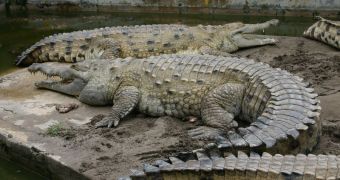On October 12, Gladys Porter Zoo's representatives went on a trip to Welland, Ontario, where they joined forces with experts, in order to save two critically endangered crocodiles. They planned to move the animals which had outgrown their cages, from their present facility, located in Canada. Therefore, they decided to move them to a more comfortable and safe habitat in Brownsville, Texas.
The initiative to save the lives of the pair of crocodiles, named Blade and Suede, is much older and it belonged to the previous owner of Seaway Serpentarium, Karel Fortyn, who passed away early this May.
He had a very ambitious plan to create a new facility for hundreds of animals considered endangered, a list which also included the male and female crocodiles.
Fortyn's strategy was to find the proper location, which these creatures could consider their new habitat. Therefore, the perfect spot would be a southern location, which would allow the crocodiles to enjoy life outside for most of the year.
Also, they would live among other Orinoco crocodiles which have already been placed in North American facilities. The process of relocation is not a simple task, since the representatives are dealing with adult crocodiles, with considerable body weight.
According to experts who took care of them, Blade measures approximately 13 feet in length and weighs 1,200 to 1,400 pounds, and Suede is 10 to 11 feet long. Her weight varies between 500 and 700 pounds.
The Gladys Porter Zoo started the process of “adoption” early this summer. In the meantime, they focused their efforts on rebuilding the perfect facility for the two new rescued animals.
Also, in order to move them from Ontario they had to comply with all the regulation. To do so, they had to face a great deal of paperwork, a process which is time-consuming.
The Division of Management Authority for the U.S. Fish and Wildlife Service made sure that the import permits would be ready on time, while taking care of the renovations for the new nest.
As part of the plan, U.S. Orinoco Crocodile organization will join forces with the team coming on behalf of Canada Orinoco Crocodile, in order to relocate the animals.
Experts have to treat this matter with a great deal of attention, since the process can affect the lives of crocodiles. Biologists have warned the organizations that during capture, a significant amount of acid is stocked in their muscles, and in some cases it is not completely processed out of their system.
Due to this fact, most of the captured crocodiles die soon after they are forced to leave their natural habitat. One can still find Orinoco crocodiles wondering in Venezuela, Columbia and South Africa.
They were placed on the list of endangered species after they had experienced a population decline of 80% during the last three generations.
The numbers continue to reflect an alarming situation, even though officials have joined their efforts in order to solve this matter, by providing the crocodiles a new, safer environment that ensures their future development.
The human intervention upon their natural habitat has had damaging effects. If in the 90's the biologists declared that 1,500 crocodiles still managed to live in their natural habitat, it seems that nowadays only 250 adults can still be spotted in the wild.

 14 DAY TRIAL //
14 DAY TRIAL //